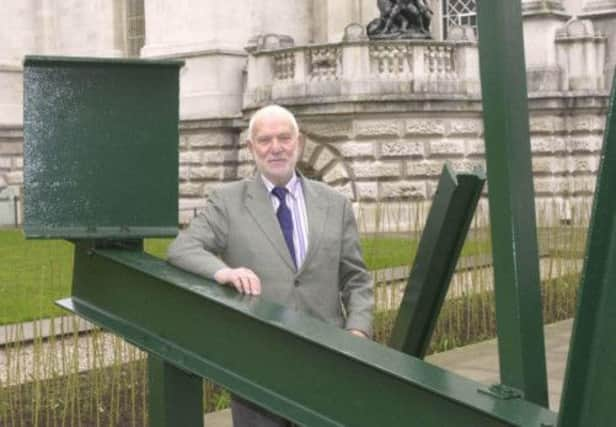Obituary: Sir Anthony Caro, OM, CBE, sculptor


Sir Anthony Caro was one of Britain’s most imaginative and innovative sculptors whose abstract art captivated – and sometimes confused – the art world for more than half a century. He had learnt his craft from Sir Henry Moore and the two had a formidable influence on art in this country and throughout the world.
His giant metallic constructions – often in vivid and beguiling bright colours – have been credited with changing the face of sculpture in Britain. His imaginative use of other metals, such as bronze, silver and lead (as well as wood), singled Caro out as an artist who wanted to look at art from a fresh and less orthodox viewpoint.
Advertisement
Hide AdAdvertisement
Hide AdCaro’s drive, energy and ability to challenge the conventional kept him in the vanguard of contemporary art and an essential creative force. Even as he approached his 90th year he was spry and energetic. He had exhibited in Venice and held an exhibition in London earlier this year. “It keeps me young,” he said with a broad smile at the opening in Venice.
Sir Nicholas Serota, director of Tate Gallery in London, said yesterday: “Sir Anthony was one of the outstanding sculptors of the past 50 years. He was a man of great humility and humanity whose abundant creativity was always evident.”
In 1982 Caro had important exhibition in Scotland, filling Glasgow’s Hunterian Museum with some majestic works. Critics warmly welcomed their sheer brilliance and bravado.
A bewitching sculpture entered the collection of the National Galleries of Scotland in 1977. Table Piece is a delightful set of sculptures that Caro had started making in 1966. The piece is number 388 of several hundred and is unusual for the artist as it was made at home in his garage. Owing to its manageable scale, Table Piece has a lightness and freedom rarely witnessed in some of his other works. It shows Caro playing with light striking the slender object with an eye-catching vivacity. The sculpture was shown in the Scottish National Gallery of Modern Art’s 50th anniversary display in 2009.
Anthony Alfred Caro, the son of a stockbroker, was educated at Charterhouse where he showed a definite talent for drawing and art. His love of sculpture was nurtured in the holidays when he attended classes. He read engineering from 1942 at Christ’s College, Cambridge and then did national service in the Fleet Air Arm.
Caro did not find it easy to decide on a career but won a scholarship to the Royal Academy School and was taken under the wing of Henry Moore. The two formed a strong bond and Caro worked under instruction on some of Moore’s works and the two visited London galleries together. Many years later Caro said: “I really started to expand my knowledge and vocabulary of art.”
His breakthrough came in 1963 at an exhibition at the Whitechapel Gallery, with a series of large, abstract steel sculptures. They were radical, controversial and exciting. Many viewers were surprised to find that the large objects were on the floor of the gallery and not on a plinth. Caro delighted in breaking the rules and not conforming throughout his career.
Three years later Sir Anthony Caro was a pioneer among British artists who exhibited in a major show in New York titled New Art. But Sir Anthony was a fine instructor and enthusiast for involving others in the appreciation of art.
Advertisement
Hide AdAdvertisement
Hide AdHe taught, twice a week, at St Martin’s School in London from 1953 to 1981.
The creative process for Caro became an industrial undertaking. He worked from a large converted studio in Camden Town and large sheets of metal were fused together or split apart. Sparks flew and the noise was deafening. But he had a very definite idea of what he was creating. From the large slabs of metal Caro created works of subtle beauty, wit and a supple elegance.
In the 1980s Caro sculpted two important works which, some consider, sum up his entire career. The first was a bronze, incorporating objects he had found in the street. The second was an erection comprising rusted bollards and filthy chains which he discovered in a dockyard.
He gave the pieces musical titles – Alton Rhapsody, Tuba and Sheila’s Song, the last named for his wife Sheila – and their glorious grandeur made an immediate impact.
More recently, his style had become less harsh and he had made known that he was planning a sculpture on a monumental scale to be erected in Park Avenue in New York. It was to occupy more than a third of a mile; the sheer audacity of the project was typical of this most inventive artist.
Caro had retrospectives at many of the leading art institutions in the world, including the Museum of Modern Art in New York, the Museum of Contemporary Art in Toyko and Tate Britain.
Caro gave many arresting interviews to Tim Marlow on BBC4’s Kaleidoscope.
He was articulate and stimulating and once, when asked what sculpture was for, said: “To please the eye and feed the soul. Human beings dance, they make music, they carve little pebbles, or stick pieces of clay together.”
Caro was an avuncular man, with a grizzly grey beard and winning smile. He married the painter Sheila Girling, who had an immense influence on his career. She and their two sons survive him.